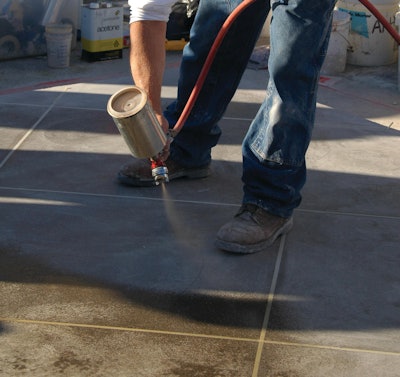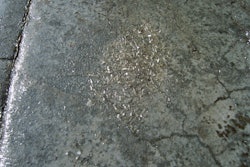
Using solvents in the course of your work as a contractor is inescapable. They are present in curing agents, coatings, stains, sealers, form releases and adhesives. You should be concerned about two things while applying them; the potential risks to your health and the risk they pose for fire or explosions. The three primary classes of solvents used on jobsites include mineral spirits, xylene and acetone.
Xylene (sometimes referred to as xylol) has had the worst reputation for health risk in the past. It’s because small amounts of benzene were in the solvent but that’s no longer the case. Generally speaking, when there is moderate exposure to all three solvents symptoms can cause nose, throat, lung and eye irritation; skin rashes; headaches; light-headedness; confusion; increased pulse rate; nausea; and vomiting. High dosage exposure can cause unconsciousness and possible death. But research concludes that light to moderate exposure causes little damage to organs and there is no connection to cancer.
Fire and explosion
The most serious risk these solvents pose is the potential for fire and explosion. Lives have been lost and homes destroyed by explosions involving acetone. To be aware of the danger you should know the risk associated with each solvent. Find the flash point, the vapor density and the flammable limits for each solvent. You’ll find them listed on their MSDS sheets. Here’s what they mean.
Flash point. It’s defined as the lowest temperature a solvent can vaporize and mix with air to create an ignitable or explosive mixture.
Vapor density. Defines whether the vapor from a solvent is lighter or heavier than air. If the vapor pressure of air is one, then any solvent vapor with a number higher than that will be heavier than air and will concentrate along floor surfaces. Vapor densities smaller than one rise to ceiling levels or into the atmosphere. Generally speaking, vapor densities above one are considered to be more dangerous.
Flammable limits. This is reported as an upper and a lower limit expressed as a percentage. The lower limit refers the least amount of solvent vapor in air to create an explosive mixture and the upper limit is the greatest amount of vapor mixed with air that can cause ignition. Vapor percentages less than or more than these limits won’t cause ignition — the area between the low and high limits represents high risk. Generally speaking, the greater the difference between lower and higher limits, the more dangerous the solvent is.
Solvent properties
Mineral Spirits: Flash Point=120 F; Vapor Density=4.9; Flammable Limits=0.7% to 5%
Xylene: Flash Point=63 F*; Vapor Density=3.66; Flammable Limits=1% to 7%
Acetone: Flash Point= -4 F; Vapor Density=2; Flammable Limits=2.5% to 12%
*There are different chemical variations of Xylene with the highest flashpoint being 86 F
Based on the above chart, acetone is the most dangerous solvent to work with — it vaporizes at a very low temperature, the vapor is heavier than air (though not the lowest), and its flammable limits are significantly greater than the other solvents
Take these precautions when using solvents:
- Wear properly rated breathing masks for the solvent being used.
- Protect hands and skin against contact with solvents.
- Turn off everything that can cause a spark.
- Turn off all flames and pilot lights.
- Remember, just turning a switch on or off can cause a spark.
- If you intend to use a fan to bring fresh air into an enclosed space, blow air into the space, don’t exhaust it. Sparks in the fan motor can cause an explosion.
- Read the MSDS information for each product.




















